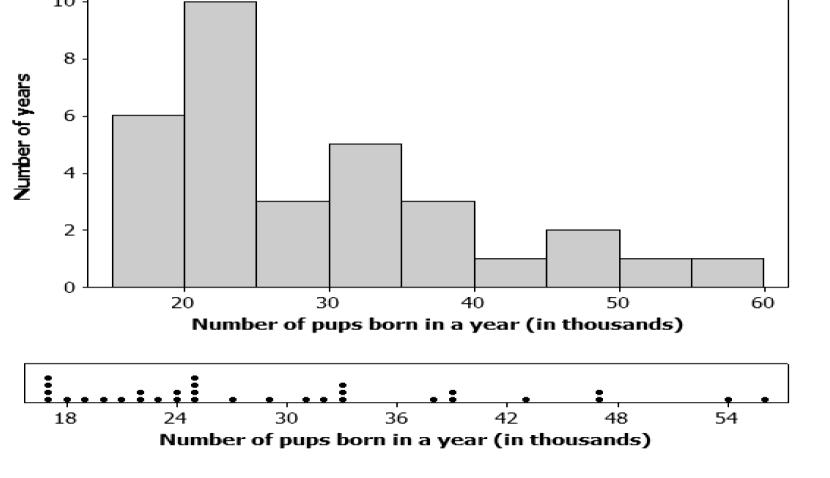The Practice of Statistics in the Life Sciences, 4th
Full chapter download at: https://testbankbell.com/product/solution-manual-for-thepractice-of-statistics-in-the-life-sciences-4th-edition-brigitte-baldi/
Chapter 1 Solutions
1 1 (a) Theindividualsinthisexercisearethedifferentbrandsofbreakfastcereals (b) Thevariablesaremanufacturer (categorical), preparationmethod (categorical), calories (quantitative),sugarcontent (quantitative),andfibercontent (quantitative).
1.2. (a) Theindividualsinthisexercisearethepatientswithfirstevertraumaticbrain injuryandsimilarhealthypeoplewithnopriorbraintrauma. (b) Thevariablesare hoursofsleep (quantitative)andsignsofexcessive daytimesleepiness (categorical).
1.3. (a) Theindividualsinthisexercisearetheyoungchildrenages fourtosix.ThevariableisTaste preference (b) Bargraphshown onrig ht (c) Yes,apiechart wouldbeappropriatebecausethe threetastepreferencesmakeup onewhole. (d) Thedatashowthat themajorityofthechildreninthis studypreferredthecrackerswitha popularcartooncharacter,whereas lessthan10% preferredthecrackerswithoutt hecharacterThissuggeststhatpopularcartooncharactersinfluencefood choicesinyoungchildren
1.4. (a) Theindividualsinthisexercisearetheyoung childrenagesfourtosixThevariableisFoodItem (b) Bargraphshownonright. (c) Asinglepie chartwouldnotbeappropriatebecausethedata forthethreefoodtypesdonotmakeuponewhole. Instead,thepercentwhochoosethecartoonversion foranygivenfoodtypeiscomplementarytothe percentwhodonotchoosethecartoonversionfor thatgivenfoodtypeAseparatepiechartwould needtobemadeforeachfoodtype. (d) Thedata showthemajorityofchildrenchoosefoodtypesthatdisplayacartooncharacteronthe packageforallfoodtypes.

1.5. Thehistogramtotherightwascreatedin MiniTab;someprogramsautomaticallyinclude thelowerendofeachclasswhileexcludingthe upperend,whileothersautomaticallyincludethe upperendofeachclasswhileexcludingthelower endEitherwayisfine;compareyourhistogramto thisone.

1 6 (a) Theappletcreatesahistogramwith7classes (b) Itispossibletogettoone classranging from 11 to 41 (notaveryuseful histogram). (c) Themostclassesthe appletwillallowis15;theclasseswiththehighestcounthaveonly2observations.
(d) Choiceswillvary;anythingfromabout6to10classesisreasonableAsamplesize ofonly18canbealittleawkwardtofitinahistogrambecauseevensmallchangesin classchoicecanhaveasubstantialimpactontheoverallookofthehistogram
1.7. The distributionoftheopioidprescriptionratesissinglepeakedandskewedtothe right.
1.8. Thehistogrami sclearlyunimodalandsymmetric,withoutoutliers.Themidpoint liesinthe14-to-15-yearsclass,whichrepresents14-year-oldgirls.

1.9. Thedotplotshowntotheright revealsthesamerightskeweddistributionthatthehistogramshows
Thedotplotbettershowsrepeated valuesoftheratesofpertussisper
100,000personsthanthehistogram Forexample,therearesixcounties thathadzerocasesreportedThe histogramshowsthatthereisacount of32countiesthathavefewerthan 20casesofpertussisreportedper
100,000personsbutdoesnotshowwhatthosevaluesare
1 10 (a) Stackeddotplotsshownto
theright (b) Glucoselevelsinthe individualinstructiongroupareless variableandappearsymmetricwith nooutliersGlucoselevelsintheclass instructiongroupareslightlyright skewedwithanapparentoutlier (c) Overall,bothgroupshaveglucoselevel sthatarenotadequately controlled.Onlyfourofthe18individualsintheclassinstructiongroup
hadglucoselevelsinthedesiredrangeIntheindividualinstructiongroup,onlytwoof the16diabeticpatientsmaintainedtheirfastingplasmaglucoseinthedesiredrange
1.11. Thetimeplotshowsaclear increaseinthenumberofdeathsfrom prescriptionopioidpainrelieversin theUnitedStatesfromtheyears2000 to2014
1 12 ThedatahavebothanobviousoveralltrendandclearcyclicalvariationsMonthly CO2 levelsvaryseasonally,peakinginthespringandbottominginthefall,creating annualcyclesButthebigpictureshowsaclearupwardtrendreflectingincreasing monthlyCO 2 levelsoverthefull40-yearperiodforwhichdataexistThissuggests thatweshouldthinkcarefullyaboutourglobalcarbonemissionsandpossibleaction courses

1.13. (a) Heightisquantitative.Youcouldcollectthedatainaspreadsheetwitheach rowrepresentingastudentandacolumnrepresentingheight.Thedatacouldbe displayedinahistogramoradotplot (b) Genderiscategorical Inthespreadsheet therecouldbeacolumnnamed”Female”andrecorda0formaleanda1forfemale Thedatacouldbedisplayedinabargraphorapiechart (c) Thedatacou ldbe sortedbygender,andseparategraphscouldeasilybeconstructedifthedatawere collectedas described in parts (a)and (b).Organizing data forusewithstatistical softwareaddressedthisissue.
1 14 (a) Thedotplottotheright showsthedataisdistinctlybimodal. Itissuspiciousandmaybeexplained byacodeformissingdata (b) The mostlikel yexplanationfortheoutliersinthedotplotismissingdata

Itseemsthata999 9 wasuseda sa specialcodeforyearsthatdidnot haveanannualmeantemperature recorded.Organizingdataforuse withstatisticalsoftwareaddressed thisissue
(c) Thecellscontaining999.9wereclearedinMiniTabtocreatethedotplotandtime plotbelow.
(d) Thetimeplotrevealsregularupanddowncycleswithanoverallincreasein annualme antemperaturesinLosAngelesfrom1880to2017.Thedotplotrevealsthat thedistributionofannualmeantemperaturesisfairlysymmetricwithatwohigh valuesfarremovedfrommostofthedataandonelowvalueremovedfrommostofthe data
1.15. (a) PregnancyStatus
1 16 (c) onecategoricalandonequantitative
1 17 (c) Thedatacanb edisplayedeitheronapiechartorabargraphbecausethe categoriesrepresentthepiecesofawhole
1.18. (a) Kidneytransplants representednearly 61% (16,898/27,793) ofallsingle-organ transplantsin2010.


1.19. (b) abargraphthatcannotbemadeintoonepiechart.
1 20 (b) Themajorityofadultswholiveinhigh-incomecountriesareoverweightand obese
1.21. (c) 31%
1.22. (a) The distribution offlea jumps is moderatelyright-skewed.
1.23. (b) single-peakedwithtwooutliers.
1 24 (b) roughlysymmetric
1 25 (a) Numberofegg sisquantitative,acount (b) Incubationperiodisquantitative, alengthoftime (c) Parentalcareiscategorical,1ofonly3possiblechoices (d) Nest sizeisquan titative,ameasureofsize (e) Presenceofpesticidesiscategorical,1of only2possiblechoices
1.26. Answerswillvary.Examplesofcategoricalvariablesare gender (boy/girl), lunch type (school-provided/home-prepared),andmilkconsumption (yes/no).Examplesof quantitativevariablesareage (in years),approximatenumberofcaloriesconsumedon the day before the interview (in Calories),and typicalnumberof fruitandvegetable servings per day (aunitlesscount).
1 27 (a) The53la kesaretheindividuals (b) Thereare5variablesrecorded,4 quantitativeand 1categorical (ageof data)Ageof data iscategorical because the only possibleentriesarerecent dataand year-old data (non-numerical)
1 28 (a) Showno n theright (b) In ordertomakea piechart,wewould needtoknowthe totalnumberof deathsinthisage group (so thatwe couldcompute thenumberof deathsduetoother causes).
1 29 (a) Therewere130“undetermined” manateedeathsinFlorid ain2012
(392 262) (b) “Watercraftcollisions” madeup 20 7% (81/392) ofall2012 manateedeathsinFlorid a (c) Shown ontheright.Ofthedea thsforwhich acausecouldbeidentified,watercraft collisionswasthemostcommon,closely followedbyperinatalandnaturalcauses.
(d) Yes,wecoulddisplaythesedatain apiechartbecause, together,theymake upallthecategoriesofmanateedeaths
1 30 (a) ShownontherightThereisaclear overweightcrisisintheadultAmericanpopulation (b) Yes,wecoulddisplaythesedata inapiechartbecause,together,thepercents inall4weightcategoriesmakeupthewhole adultpopulation.ThepiechartwouldemphasizethatmorethanhalfoftheadultAmerican populationiseitheroverweightorobese.
1.31. (a) Shownontheright.Allagegroups havealargerateofobesity.Adults45to64 and65to74havethehighestpercentage ofobeseindividuals. (b) No,wecouldn’t displaythesedatainonepiechartbecause thepercentsinthe4agegroupsdonotmake upthewholeadultpopulationEachpercent representsadifferentagegroupseparately


1 32 (a) Thedistributionisbimodal,withaspreadof0to75percentofcorrectquiz answersThe firstpeakislocatedaround10to15percentcorrectanswers,andthe secondpeakislocatedaround45to50percentcorrectanswers.
(b) Thissuggeststhat therear et wotypesofindividualsclaimingtohaveHSAM:individualswhoperform poorlyandareunlikelytotrulyhaveHSAMandindividualswhoperformmuchbetter andaremorelikelytotrulyhaveHSAM.
1 33 A bar graphwould beappropriate for (a)and (d)because the dataarecategorical A histogramwould beappropriate for (b)and (c)because the dataare quantitative
1 34 (a) Thedistributionisunimodal,moderatelyskewedtotheright,withoutoutliers

Thesp readofthedistributionis0to30percentcorrectquizanswersThecenter ofthedistributionislocatedsomewherebetween5and15percentcorrectanswers
(b) Thehistogramforthecontrolgroupissimilartothefirstpeakofthebimodal
histogramforthegroupclaimingtohaveHSAMThisconfirmsourinitialsuspicion that individualswho perform poorly (similartothecontrol group)are indeedunlikely totrulyhaveHSAM,unlikethehigh-scoringindividualsmakingupthesecondpeakof thetophistogram
1.35. (a) Thefirst histogram (on the left)shows possiblytwo modes: 5
5.8. (b) Thesecond histogram (ontheright)has peaks in locationsclosetothoseof the first,butthesepeaksaremuchlesspronouncedandmorelikeasinglebutverywide peak.

1 36 (a) Thehistogramisshownontheright
(b) Thedistributionissharplyskewedtotheright
Only7ofthe30foodoilshavemoreomega-3than omega-6 (ratio greater than 1),somostoils donot havethedesiredratio. (c) Thefishoilsare5ofthe 7oilsthathavearatioover1.
1 37 (a) Healingratesarefairlyevenly spreadout,withaslightlyhigher densitynearthecenter (b) The stemplotrevealsasymmetricdistributionwithnooutliers (c) Both thestemplotandthedotplotreveal thedistributionissymmetricwith nooutliersandbothdisplaythe rawdata.Thedotplotshowsbetter howthedataisspreadoutandthe stemplotshowsbetterthesymmetric characteristicofthedata
5.2 and 5.6
1 38 (a) The individualsarethesetofpeople thatself-reportedtheirweightandheight ineachstateandtheDistrictofColumbia Thevariableisthepercentofthepopulation thatisobeseThevariableisquantitative (b) Thehistogramanddotplotareshownto theright.Thedistributionofthepercentof adultsineachstateandD.C.isapproximately symmetricwithnoclearoutliers.Thecenter isaround 29%, andthespreadisfrom 21% to 37% (c) Mostof theMidwest,West,andSoutheasthaveobesityratesbetween 20% and 35% Thereare threestates (Arkansas,Mississippi,and West Virginia)that have obesityra tesgreaterthan 35% Thisgeographiccharacteristicoftheratesofobesity couldnot beidentifiedfromthedatatable,dotplot,orthehistogram

1.39. (a) Shownbe low. (b) Thedistributionofflowerlengthsisunimodalandskewed totheright.

1.40. Thehistogramanddotplotare shown ontheright.Thedistributionis skewedtotherightbutdoesnothave clearoutliers.Thecenterisaround25 pups per year,and thespread is from 17 to56pupsperyear.
1.41.(a) Dotplotsshownbelow.Tumorincreasetendstobesmallerwithnanoparticle treatment.Thedistributionoftumorincreasesisskewedwithnanoparticles,whereas itissomewhatsymmetricanduniformwiththebuffertreatment. (b) Themidpoints areabout6withbufferandabout2withnanoparticles.Themostimportantdifference revealedbydotplotsisthatnanoparticletreatmenttumorincreasetendstobemuch

lowerthanbuffertreatmentwithverylittleoverlapThestudyfindingsshowthereisa differenceintreatmentgroups
1.42. Thetimeplotshowsthatthenumber ofsealpupsborneachyearhasdeclined fairlysteadilyinthatperiod,althoughmore slowlysoinrecentyears.Thistrendcannot beseeninadotplotorahistogram.



1.43. (a) Timeplotshownontheright.There isa clearincreasingpatternsincethemid1970s,butnocyclicalvariations.Thenumber ofuniquecasesofherbicideresistanceinweeds worldwidehasincreaseddrasticallyovertime, fromnearlynothingbeforethemid-1970sto nearly400in2012 (b) Theclearpatternover timewouldbemissedinahistogramItis alwayswisetoplotdatacollectedovertimein atimeplotfirst
1.44. (a) Thepercentofrespondantsthatexercisedregularlyisthehighestinsummer andthelowestinwinter. (b) Thelongtermtrendisagradualincreaseinthepercent ofrespondentswhosaidtheyexercisedregularlyfrom2008to2016.
LARGEDATASETEXERCISES:
ANSWERSGROUPEDIN“LARGEDATASET”CHAPTER
Exercise1 45 Everglades
